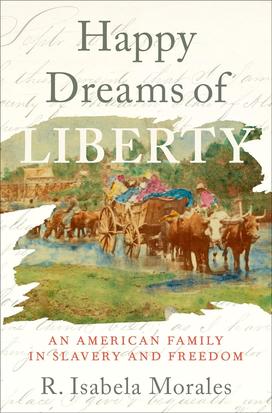R. Isabela Morales *19 Builds Book on Slavery From her Dissertation
The book: In Happy Dreams of Liberty (Oxford University Press) Morales highlights the story of a mixed-race family in the U.S. West and South from the antebellum period through the rise of Jim Crow. It all starts with Samuel Townsend, who left behind hundreds of enslaved people and a net worth of about $200,000 as his legacy when he died in 1856. He left that fortune to his five sons, four daughters, and two nieces, who had all been enslaved by him. Morales unpacks the complexities the extended Townsend family experienced as they migrated across America and figured out what to do with their newfound freedom. A story of both opportunity and oppression, Happy Dreams of Liberty examines themes of race, freedom, and social and economic mobility.

The author: R. Isabela Morales *19 earned her undergraduate degree in history and American studies from the University of Alabama, her master’s from Princeton, and her Ph.D. from Princeton. She specializes in the 19th-century United States, slavery, and emancipation. She is the education and exhibit manager at the Stoutsburg Sourland African American Museum (SSAAM) and editor and project manager of The Princeton & Slavery Project. Her book Happy Dreams of Liberty is one of the winners of this year's Frederick Douglass Prize from Yale's Gilder Lehrman Center — an annual prize recognizing books written in English on the topics of slavery, resistance, or abolition.
Excerpt:
Chapter Two, pp. 40-46
Samuel Townsend’s Home Place was a world unto itself. Fields of cotton, wheat, corn, and oats surrounded barns for horses, tools, and equipment, herds of hogs and goats and cattle, bee stands for honey, spinning wheels to make cloth, a fully functioning blacksmith shop, and a cotton gin house large enough to accommodate not only Samuel’s crop but also the cotton of his planter neighbors in Hazel Green. Just one among Samuel’s eight plantations, the 1,700-acre Home Place was more like a small village than a farm: the antebellum South in microcosm. In 1940, one local historian puzzlingly remarked that the planter had lived “a very simple life.” Yet Samuel slept on a feather bed in his big house, a stand of fruiting pecan trees shading it from the Alabama sun, while hundreds of bondsmen, women, and children worked for his benefit. They lived in a cluster of small cabins west of the house—what the residents of Hazel Green called, simply, “Townsend’s Quarters.” On the Townsend plantations, as in southern society more broadly, a small group of white elites lived in incredible luxury, an aristocratic lifestyle supported by the forced labor of enslaved people. Also like southern society at large, on the Home Place an intermediate class existed: not free people of color, not yet, but Samuel Townsend’s children.
A slave owner having children by his slaves was not, in itself, anything unusual, and it was virtually impossible to keep secret. Though theoretically taboo in a society that preached the innate racial inferiority of African Americans, sex across the color line was a fact of life in the antebellum South and one tacitly accepted by white communities. Even when a white man did attempt to hide his relationships with enslaved women, the presence of children bearing a resemblance to the plantation master could be hard to explain away—though of course they could always be sold away. “You couldn’t tell the difference between the children he had by his slaves & those he had by his wife,” an ex-slave named John Boggs recalled in 1863, when asked about his old master’s family. “He used to have some Irishmen on the plantation, and he said these children were theirs, but everybody knew they were his. They were as much like him as himself.” Family who knew or saw or guessed, friends and neighbors who gossiped, enslaved people meeting in town on half-days or visiting kin on other plantations: it was only a matter of time before a white man’s dalliances became common knowledge. The trick was not talking about it. Demonstrating extravagant favoritism for an enslaved child or concubine violated the rules of polite society and, if a slave owner went as far as manumission, the rules of white supremacy. Some plantation mistresses insisted that slaves they suspected of any sort of relationship with their husband, sexual or familial, be whipped or sold. But in exchange for a modicum of discretion, at least in public, others simply looked away. As South Carolina diarist Mary Boykin Chesnut famously quipped: “Every lady tells you who is the father of all the Mulatto children in everybody’s household, but those in her own, she seems to think drop from the clouds.” Or at least, Chesnut added, “she pretends so.”
The Townsend brothers had never worried much about the rules of polite society, but as lifelong bachelors Samuel and Edmund had even fewer curbs on their behavior than married slave owners. With no wives to challenge how they arranged their private or public lives, the Townsend men spoke openly about their children with friends and neighbors—Samuel “kindly and tenderly,” and Edmund in such a way that the sheriff of Madison County came to believe that Elizabeth and Virginia were in fact free girls “much beloved” by their father. Samuel’s children knew that their mothers were slaves—they saw them working in their father’s fields, enduring chronic pain and injuries from decades of hard labor—so they knew, as their cousins had not, that they were not legally free people of color. Under Alabama law they could be beaten, bought, and sold just like any other person owned as property. But they were also Samuel’s children, as recognizably so as those of John Boggs’s former master. Multiple descriptions of the enslaved Townsends noted their “light complexion”; later in life, a white government official describing Samuel’s daughter Milcha would write that “The Woman is nearly white.” The resemblance went beyond skin color. One neighbor commented that Samuel’s children “generally favored him very much,” and Samuel’s lawyer would later tell Willis Townsend that his child by a local woman, likewise, “favors the Townsend family very much.” Perhaps Osborne Townsend’s gray eyes came from his father’s side.
Samuel’s children occupied privileged positions on their father’s plantation, with his sons learning skilled trades and his daughters exempted from fieldwork. … Samuel’s eldest son Wesley was a talented blacksmith and carpenter, trained by an enslaved man named George who had run the blacksmith shop on the Home Place for decades, forging tools and shoeing horses. Wesley would have taken over from George sometime in the 1850s, when George grew so “Rheumatic” that an inventory of Samuel’s property declared the man worth precisely “0.00” dollars. Wesley, on the other hand, performed work that netted his father a small fortune. One project alone—“a good work of a wagon” that twenty-four-year-old Wesley built and painted for a local farmer in 1855—cost the man $100. The money, of course, went to Samuel. By age eighteen Samuel’s second-eldest son Willis would also work as a blacksmith on the Home Place, first assisting Wesley and then “striking in the shop” on his own. But decades later, when the younger Townsend brothers reminisced about their childhoods, they recalled incidents that suggested they had a special status in Hazel Green even before they were old enough to take up a trade.
Do you remember, Osborne wrote his brother Thomas in 1888, “the old fellow that caught us kids one Sunday morning going chestnut hunting”? It was Abner Tate, a neighboring cotton planter, who had caught them on his property—alerted perhaps by the barking of the boys’ hounds getting in among his livestock. Furious, Tate threatened to “lick us for having the dogs on his hogs,” but their friend Harrison (perhaps the property of one Townsend or another) “jumped up on the fense and hollowed” for Mrs. Tate, who promptly appeared and scolded her husband to leave the boys alone. Their relation to Samuel and Edmund shielded Osborne and his brothers from the worst brutality regularly meted out to other enslaved people in Madison County. Slave patrols hunted and terrorized runaways by setting dogs on them; Samuel’s sons took their father’s dogs out to run wild on another slave owner’s farm. Edmund Townsend had a man whipped to the bone because he suspected him of killing two of his hogs; caught red- handed among a neighbor’s hogs, Edmund’s nephews escaped with no more than a reprimand. Perhaps if Harrison had been alone, that Sunday morning would have had a very different ending.
But the fact that the two planters recognized and favored their children in some respects did not mean that the enslaved Townsends weren’t subject to the control that masters held over people legally considered property. In fact, their lives on the Home Place may have been under greater scrutiny precisely because the brothers did consider them family. … Yet even in their vulnerability, the enslaved Townsends may have seen their relationship to their master as something they could leverage into permanent liberty. Most enslaved people on the Home Place knew the only way they would ever go free was if they ran—like Dick and Owen, who took advantage of the upheaval over their master’s death to successfully escape in 1856. The enslaved Townsends, however, saw other possibilities. They knew what Edmund had tried to do for his daughters Elizabeth and Virginia and his sons Armstead and Woodson. They knew that they could rely on Samuel to expend time and money getting them out of even the direst legal trouble. Local whites recognized their special status too: their parentage, their skilled work, the way Samuel and Edmund treated them. At the same time, Samuel’s children and concubines also knew just how fragile that status was. While their relation to their master gave them certain opportunities and immunities, the fact of their enslavement made their privileged positions inherently unstable. In a community as committed to slavery and white supremacy as Madison County, Alabama, all it took was one man’s death to see those opportunities destroyed. … Even so, the enslaved Townsends knew that Samuel’s acknowledgment of them as family was their best hope for emancipation. When Wesley’s mother Rainey gave birth in 1853—the same year Edmund’s will was broken and Samuel began writing the first draft of his own—she named her infant son “Freeman.”
Excerpt from Happy Dreams of Liberty: An American Family in Slavery and Freedom by R. Isabela Morales. Copyright © 2022 by Oxford University Press and published by Oxford University Press. All rights reserved.
Reviews:
“Captivating and thoroughly researched, this poignant multigenerational saga gives a voice to a type of family that been traditionally absent from the historical narrative.” — Anne Ulentin, University of the Bahamas, Journal of Southern History.
“Morales’s engrossing family history is the product of old-fashioned archival research, cutting-edge analysis, and brilliant writing. With empathy and imagination, she recreates the lives of a remarkable group of men and women, born into slavery, freed in one enslaver’s will. We see and feel their dreams of freedom and opportunity along with their lifelong efforts to achieve them. It’s a peculiarly American story. It’s anything but black and white.” -- James Goodman, author of Stories of Scottsboro












No responses yet